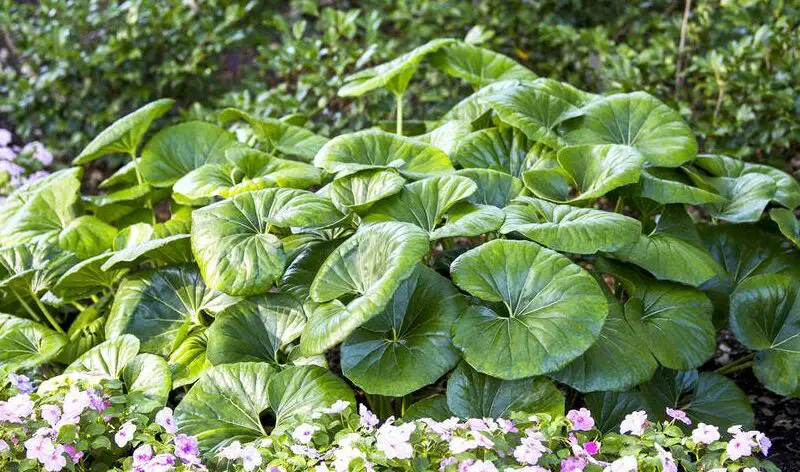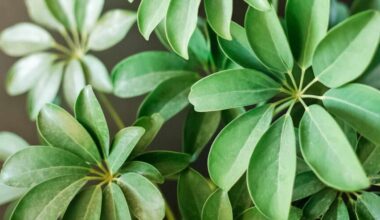Perennial with an imposing fresh, kidney-shaped and finally very ornamental foliage, Farfugium japonicum is native to East Asia and Japan, also called Leopard Plant. It likes to grow in humid meadows and along wooded streams. It is thus in a part of humid undergrowth that the leopard plant will grow best in our gardens.
Contents
Where to plant the Leopard Plant?
Concerning the exhibition, the leopard plants are perennials of shade or semi-shade, especially in pots. The sun damages the foliage which then tends to wither. The wind can also damage the foliage, so consider protecting the plant from it.
The soil should be rich and moist and remain cool, even slightly damp. The plant is indifferent to the pH.
When to plant the Leopard Plant?
Planting is preferably done in spring in April or early autumn, during the months of September and October.
How to plant in a pot?
- Take a large pot of at least 12-16 inches because the plant will fill it up quickly.
- Put a layer of clay balls or other draining material in the bottom of the pot.
- Make a mixture of 2/3 potting soil or garden soil and 1/3 compost.
- Remove and put the plant in the pot and fill the spaces with substrate.
- Water well and place in a shady place.
- At the very beginning of the spring, make a contribution of fertilizer or well matured compost.
- Repot every 2 or 3 years when the plant really starts to get cramped.
Maintenance of the Leopard Plant
The plant is hardy only at 19°F and the foliage already disappears at 14°F. Don’t panic however, it will come back the following spring. But in autumn, protect the strain well with a thick mulch or if your leopard plant is grown in a pot, put the pot in a cold greenhouse (an unheated veranda for example). In the spring, a supply of ripe compost or decomposed or granulated horse manure will be appreciated.
You can cut the flower stems when the flowers wither in late autumn. Some gardeners simply prefer to sacrifice the bloom to enhance the foliage. It’s up to you! (but, I find it a shame personally…)
Multiplication of Farfugium
Forget categorically about sowing or possible cuttings, rather favour the division of tufts in April.
In reality, Leopard Plants produce rhizomes that spread and deviate from the original clump. The simplest way to do this is to locate one of these rhizomes and cut it with a spade or knife and replant it elsewhere.
Note that sowing is possible but only for the typical species, the varieties will not be reproduced faithfully.
Diseases and parasites of the Leopard Plant
No disease attacks leopard plants.
Beware! Like their botanical close cousin, the Ligularia, the Farfugium seems to attract slugs and snails like a magnet. So watch the grain and protect your perennials accordingly! Discover our tip sheet: Slugs: 7 ways to fight effectively and naturally.
How to associate the Leopard Plant?
In wet undergrowth
Under a few trees with a beneficial shade, your garden offers you a very humificient soil. In addition, a nearby pond provides a pleasant humidity in the atmosphere but also at ground level. It is the perfect place to host a Farfugium japonicum ‘Gigantea’ with large and exotic leaves. Why not accompany it with beautiful tree ferns, whose cut fronds will contrast strongly with the foliage of the leopard plant. Accompany them with a Cycas revoluta and an Elderberry with purple foliage to bring a little contrast in all this green.
An exotic combination idea: Tree Fern, Sambucus nigra ‘Black Beauty’, Cycas revoluta and Farfugium japonicaum ‘Gigantea’.
Another idea would be to accompany the fall flowering of the Leopard Plant, a “friend from Japan” would be an excellent idea. A ‘Cheju-Do’ Actea japonica ‘Cheju-Do’ with silver-glazed foliage in spring and multiple spikes of white and slender upright spikes. Let’s stay in Japan and the autumn blooms with this very pretty Anemone of Japan ‘Rubra Plena’ with its semi-double dark pink flowers.
Finally, let’s not forget a beautiful contrast of shape and color of foliage with some tufts of Japanese sedge, Carex morrowii ‘Aureomarginata’, with its supple, evergreen, yellow foliage with a strong green border that will illuminate the darkest corners of the garden.
In pot in the shade
At home, winters are too harsh to let Leopard Plants grow in the ground? Don’t panic, they live very well in large pots that we will store in winter in a cold greenhouse. But in the meantime, it will be the occasion of a small scene of perennial that will appreciate the shady and humid atmospheres and that do not suffer from being grown in pots.
Farfugium japonicum ‘Crispata’ is a rare form, with intensely wavy foliage along the edges and, moreover, it is more compact than the typical species and will hardly exceed fifty centimeters in all directions. A beautiful clump of Japanese grass, Hakonechloa macra ‘Aureola’, with beautiful arched foliage and variegated green variegated with golden stripe will keep him company. A small place can be found for a mini collection of Hostas with various foliage such as Hosta ‘Morning Light’, Hosta ‘Rainbow End’ and Hosta ‘Clifford’s Forest Fire’.
Finally, a beautiful pot of Ligularia, the close cousin of the Farfugium, can be placed in the presence of a Ligularia stenocephala, with long, thin spikes of tiny yellow flowers borne on brown-black stems emerging from a massive tuft of shiny, heart-shaped leaves.
Summary
Farfugium japonicum, the leopard plant, is a hardy shade plant, whose yellow flowers and large shiny semi-persistent leaves illuminate the darkest corners of the garden.









